It doesn’t matter how big or how small, hairy or bald every dog breed needs grooming. In this article, I will be going over the basic grooming needs of every breed. Remember to always reward your dog after every procedure by playing, a good belly rub or whatever it is they enjoy.
Grooming – What Every Dog Needs
How to Bath your Dog
Bathing your dog is part of basic grooming and should be done at least once a month. A lot will depend on your dog’s lifestyle.
Once you have your dog in the tub or sink get the water temperature to 70-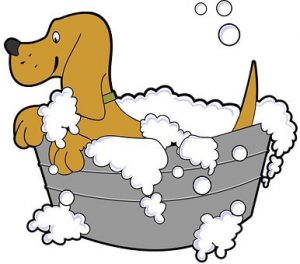 80 degrees. It should feel room temperature to you, any warmer can lead to your dog overheating any colder will lead to your dog getting chilled and shaking. Also using water that is too hot will cause your dog’s skin to dry and become itchy. Start wetting your dog down by starting at the head. Never spray water directly into the face and avoid getting water in their ears. You can do this by gently grabbing the base of the ear and pinching it closed while wetting. Hold your dog’s snout upward while wetting the head. This will avoid water running down into the nostrils.
80 degrees. It should feel room temperature to you, any warmer can lead to your dog overheating any colder will lead to your dog getting chilled and shaking. Also using water that is too hot will cause your dog’s skin to dry and become itchy. Start wetting your dog down by starting at the head. Never spray water directly into the face and avoid getting water in their ears. You can do this by gently grabbing the base of the ear and pinching it closed while wetting. Hold your dog’s snout upward while wetting the head. This will avoid water running down into the nostrils.
Make sure your dog it completely wet before applying the shampoo. This will make it easier to spread the shampoo and work up a good lather. Apply the shampoo starting at the neck. Use a tearless shampoo for their head and face. Build up a good lather by adding more water as needed and spread it to completely cover your dog. Pay close attention to those out of the way places like under the front legs, the belly, and the rectum area. Allow the shampoo to sit on your dog according to the instructions on the bottle. Flea and medicated shampoos require a longer leave on time.
Rinsing and Drying
Rinsing the shampoo off your dog is one of the most important parts of the bath. You want to do a thorough rinse once again paying close attention to the belly, rectum and under the front legs. The entire coat should feel squeaky clean. Leaving shampoo residue on your dog can result in a dry and itchy skin condition.
Now it’s time to apply a coat conditioner if needed. The conditioner you use will depend on what type of coat your dog has, leave on according to the instructions on the bottle then rinse. Once you have thoroughly rinsed gently squeeze off any excess water and allow him/her to shake. Remove your dog from the tub or sink and wrap him/her in a dry towel, you may need several towels depending on the size and coat of your dog.
For beginners, I recommend trying the white towel test. Use a white towel to dry your dog, if you see any dirt on the towel you will know you missed a spot. This is usually the result of not doing a thorough rinse.
After towel drying it’s time to dry your dog with a hairdryer, I recommend using a hairdryer made for pet grooming. If your dog has wavey to curly hair you will need to know how to Fluff Dry. If needed please Click Here to learn. Don’t let your dog outside while he/she is still wet, everything will stick to them and you will end up with a dirty dog again.
How to Clean Your Dogs Ears
I recommend cleaning your dog’s ears after every bath. Furthermore, you will want to clean more often if you own a floppy-eared dog or a dog that loves to dig in the dirt. Floppy-eared dogs tend to get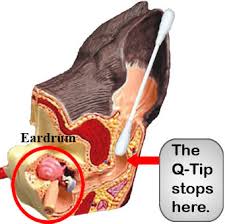 more ear infections. This is due to the fact that airflow does not get to the ear canal as freely as a dog with stand up ears. Moisture plays a major role in most ear infections like ear mites that thrive on the moisture in the canal.
more ear infections. This is due to the fact that airflow does not get to the ear canal as freely as a dog with stand up ears. Moisture plays a major role in most ear infections like ear mites that thrive on the moisture in the canal.
Do not worry about hurting your dog’s eardrum when cleaning with a Q-Tip or cotton ball. The dog’s ear canal is in a “J” shape putting the eardrum out of reach. You can clean the ears with an already made ear wash specifically made for dogs. If you prefer you can make your own mixture of 1 part Rubbing Alcohol to 1 part Hydrogen Peroxide. Pour the ear wash into your dog’s ear to fill the canal. Give the ear a few gentle rubs then wipe out with a cotton ball. Use a Q-Tip to get into all the nooks and crannies that are in the ears.
If you notice your dog shaking his/her head a lot it could be due to an ear infection. While cleaning the ears look for signs of an infection like redness in the ear, a dark brown clumpy discharge, puss, and/or a bad odor. If you notice any of those signs I recommend taking your dog to your vet for treatment. Letting an ear infection go untreated can result in irreversible damage.
Dogs that have Hair in the Ear
Some dog breeds have hair that grows inside the ear canal. This hair needs to be removed to help prevent ear infections. This is done by plucking the hair out in the same manner that someone would do when plucking their eyebrows. I recommend using your fingers and not a tweezer or hemostat because a tweezer can pinch the skin and/or scratch the ear canal if not used properly. In all my years of pet grooming, I have always used my fingers.
This procedure should be done before bathing. Start by shaking some ear powder made for dogs into the ear canal. Using your thumb and index finger start plucking the hair out. Grab small bunched of hair at a time, grabbing too much hair at one time will make it harder on you and your dog.
How to Clean your Dogs Teeth – Make it a part of the Grooming Routine
This process may take some getting used to for you and your dog, for best results start when your dog is relaxed. Brushing your dog’s teeth should be done daily or at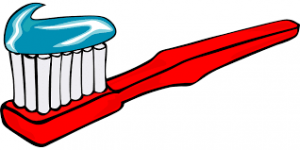 least 1-2 times a week. And should be professionally cleaned by your Vet at least once a year. There are several teeth cleaning products made especially for dogs that you can choose from, choose what you feel will work best. Never use a toothbrush or toothpaste made for people.
least 1-2 times a week. And should be professionally cleaned by your Vet at least once a year. There are several teeth cleaning products made especially for dogs that you can choose from, choose what you feel will work best. Never use a toothbrush or toothpaste made for people.
Start by giving your dog a taste of the toothpaste so he gets used to it. Apply a small amount of toothpaste to a wet toothbrush, lift your dog’s lip/jowls to expose the gum and teeth, gently begin to brush his/her teeth as you would your own. Allow him/her to drink some water and give a reward for a job well done.
How to Trim Your Dogs Nails
Notice, I am using the word trim and not cut. You never want to cut too far back on the nail, you will just be trimming the end tips. How often you trim your dog’s nails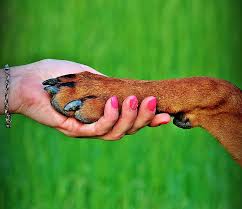 depends on the surfaces he/she is walking on. Dogs that spend a lot of time on concrete tend to have shorter nails. The concrete works like a nail file and does a nice job of keeping the nails trimmed. If your dog spends most of his/her time indoors on a nice comfy carpet than nail trimming will need to be done more often. There is a vein that runs inside your dog’s nails called the Quick, you want to avoid cutting it. You will need to have some styptic powder or cornstarch handy in case the quick begins to bleed.
depends on the surfaces he/she is walking on. Dogs that spend a lot of time on concrete tend to have shorter nails. The concrete works like a nail file and does a nice job of keeping the nails trimmed. If your dog spends most of his/her time indoors on a nice comfy carpet than nail trimming will need to be done more often. There is a vein that runs inside your dog’s nails called the Quick, you want to avoid cutting it. You will need to have some styptic powder or cornstarch handy in case the quick begins to bleed.
Place your dog’s paw into the palm of your hand. Firmly hold the nail clippers, place the nail trimmer under your dog’s paw. Slide the nail into cutting position and trim the tips of the nails one at a time. If your pet begins to get antsy or irritated take a break. You do not have to trim them all in one sitting. I see no need to stress out your dog over this. After trimming you will need to file down the rough edges. Use a strong nail file to make the end of the nail nice and smooth.
Don’t forget the Dewclaw
Some dogs have both front and back dewclaws, these are the nails on the side of your dog’s leg. It is very important to trim these regularly due to the fact they do not get walked on. 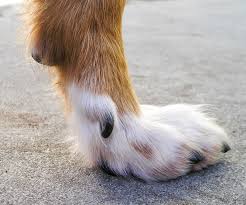 The dewclaw will tend to grow faster than the other nails. Some will grow into a curl and can actually grow back into your dog’s leg if neglected. As a result, it can be very painful and lead to an infection. If this happens you will need to take your dog to a Vet to have them cut out.
The dewclaw will tend to grow faster than the other nails. Some will grow into a curl and can actually grow back into your dog’s leg if neglected. As a result, it can be very painful and lead to an infection. If this happens you will need to take your dog to a Vet to have them cut out.
Here is another tip you should know. The quick grows with the nail. The longer the nail gets the longer the quick will get. By trimming frequently the quick (vein) will begin to reseed and you will able to trim the nails shorter over time.
[
What to do if you cut the quick
Most of all, Do Not Panic! It will look a lot worse than what it is. Cutting the quick is not life-threatening and you can stop the bleeding relatively fast by applying a styptic powder or cornstarch. Place some styptic powder or cornstarch in the palm of your hand. Take the bleeding nail and dip it into the styptic powder or cornstarch completely covering the tip of the nail. You may need to repeat this several times before the bleeding stops. Do not let your dog walk on it for a few minutes.
How to Brush your Dog
Brushing your dog is an important part of grooming. This should be done on a regular basis to avoid excessive shedding in short and thick-coated breeds and tangling in long-haired breeds. The brush you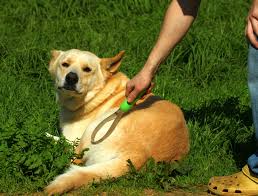 choose will depend on your dog’s coat. Knowing what brush works best for your type of dog will be more effective with better results. To get more info on Dog Brushes please Click Here.
choose will depend on your dog’s coat. Knowing what brush works best for your type of dog will be more effective with better results. To get more info on Dog Brushes please Click Here.
Brushing your dog not only keeps his coat from building a heavy undercoat and tangling it also massages the skin to stimulate new hair growth and the skin’s natural oils for a healthier-looking coat.
Start at the head and work your way down the back. When brushing a long-haired dog you will need to lift the hair with your hand. As you brush pay more attention to the areas that tend to tangle easily like behind the ears, chest, neck, and under the front legs. Always brush first to loosen and remove tangles then go back over your dog’s coat with a comb to catch tangles and loose hair the bushing may have missed. I recommend using a dog hair/coat conditioner for all breeds. You can find some great detangling sprays made for long-haired dogs. Never bath your dog if his/her hair is tangled and matted or if your dog has a heavy undercoat. As a result, the water and shampooing will tighten the mats and/or undercoat making it almost imposable to brush out. Always thoroughly brush your dog before bathing.
When you’re all done grooming visit our Pet Boutique to give your pooch the Finishing Touch!
I hope you found these grooming needs for every breed to be helpful, if you have any questions please leave me a comment. I will get back to you ASAP.
Happy grooming,

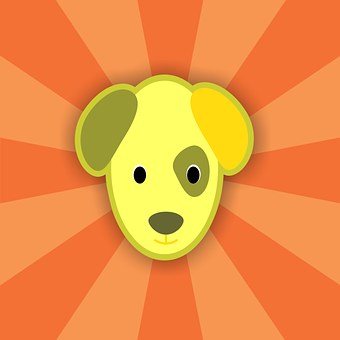
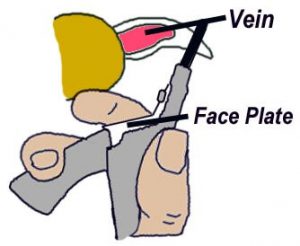
Thanks for all your tips on bathing and grooming a dog. I didn’t know that there were so many things to consider, like their nails and their ears, on top of just their fur or hair. I am thinking about getting a dog for my kids, but I don’t know if they would have enough time or attention to regularly groom a dog like this. I think finding a grooming service in our area might be the best solution if we do end up getting a dog.
Hi Jenna,
Glad you found this information to be helpful. I hope you find your new family member soon, maybe you should think about getting a shorthaired dog if you’re not up to doing all the grooming that is needed. Thank you for visiting my site!
My husband and I groom our own dogs, so these are definitely helpful tips for dog owners to remember. Everyone is looking to save a few dollars, so I think it’s getting pretty common for dog owners to groom their dogs themselves. And thanks for adding the part about cleaning a dogs ear with a q-tip – I didn’t know that was a safe thing to do.
Hi Elsa,
I am glad your found the information to be helpful. I agree with you that more and more people are learning to groom their pets at home to save money. That is why I want to help people learn how to properly groom their pets. Thank you for visiting my website.
Hi Cathy, I loved your website.
My wife and I own a Maltese x Bichon Frise and a Frenchie. Although we don’t have to worry about the Frenchie as far as hair goes, our little Maltese is a different story when it comes to shaving him.
I had no idea that shaving your dog can cause overheating. In fact when we saw him panting in the warmer months of summer, we just thought it came down to carrying too much hair.
Also found your website very informative, easy to read and navigate.
Cheers…
Wayne
Hi Wayne,
Yes, many people do not realize the effects of shaving down their dog. I am hopping to help as many pet owners as I can, after all they are a part of the family too. I’m glad you found my site to be helpful. I am working on a blog about caring for the long haired dog now. Please come back for a visit soon.
A dog’s role in our life has changed a lot. When I was a child the dog lived outside and had his own kennel for shelter and to sleep in. Now a dog is another family member that lives in our house and even, in some cases, sleeps in out bed. This makes grooming very important. The one thing I cannot get my head around is teeth cleaning. Is this really necessary? I have always thought chewing bones was how a dog cleaned their teeth.
Hi Margaret,
Yes, many things have changed in the way we care for our pets. They have found that many dogs suffer from tooth decay and gum disease. It can be very painful for them and the owners may never realize it until it’s too late. Certain bones designed for dental care do help but it is recommended to also brush your dogs teeth. Thank you for stopping by.